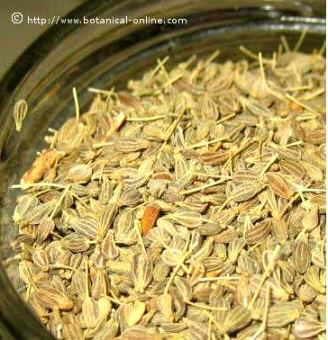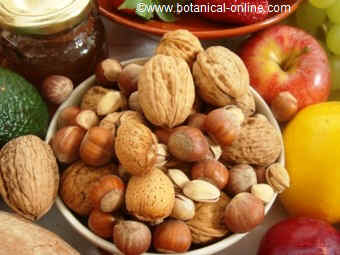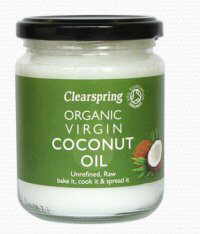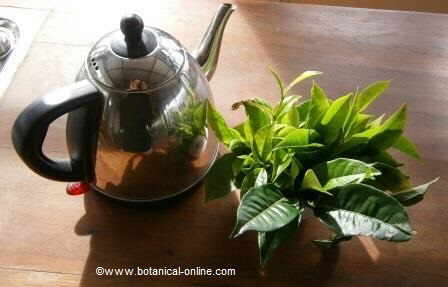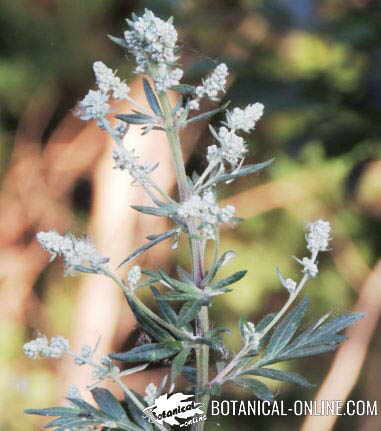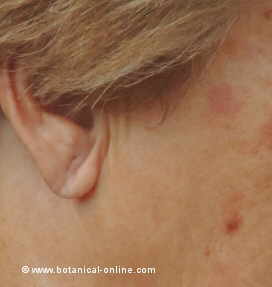Contents
Medicinal benefits of yarrow (Achillea millefolium L. )
Medicinal properties of yarrow herb
Internal use remedies with yarrow herb
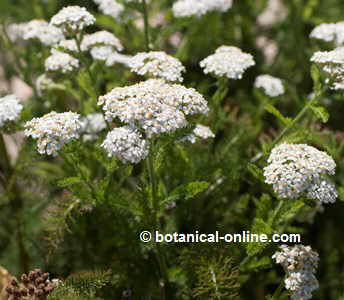
- Astringent and anti- diarrheic: Being very rich in tannins, as well as chamazulene and apigenin, bestows it anti-diarrheic and astringent properties. Very useful when having diarrhea or colitis. (Infusion of a tea spoonful of floral summits by each glass of water. Drink a couple of cups a day.)
Because of being astringent, antibacterial and antispasmodic properties, it is interesting to use in the treatment of diverticulosis or diverticulitis. (Infusion of this plant half teaspoon per cup of water. 2 cups per day) - Circulatory system diseases: To diminish blood pressure one can drink a couple of glasses of the above mentioned infusion. In the same way a maceration can be realized with three spoonfuls of floral summits in a liter of white wine during 7 days. Drink three little cups a day, each one after each main meal.
These two remedies are very efficient in the internal treatment of hemorrhoids and varicose veins, taken into account that using this plant favours the blood circulation, strengthens the veins and diminishes their swelling.
The same that happens with the leg and anal veins, is also applicable to the general inflammation of blood vessels (Phlebitis, cataracts, etc.). All this properties must be attributed to the anti-inflammatory properties of azulene and specially to the salicylic acid.
High in tannins, chamazulene, apigenin, and luteolin that give it astringent properties. The powder of yarrow can be inhaled through the nose to treat nosebleed. (Inhale a speck of dust made by grinding the dry plant) - Respiratory tract: Acid ascorbic – vitamin C – because of its bactericide and depurative properties makes it suitable for the treatment of most frequent respiratory diseases, such as bronchitis, cold and influenza as well as to a avoid respiratory spasms in tuberculosis, asthma, allergies and hay fever (Steam inhalation of a handful of flowers in a liter of hot water)
- Digestive and tonic: Flavonoids grant it antispasmodic properties very useful in case of intestinal spasms. On the other hand, the sour principles give it digestive properties to treat flatulence, indigestions, heartburn, vomiting and also as an appetizer when inappetence is present.
In all these anomalies, a mixing of tincture of chamomile and yarrow can be a very good resource. (Take 4 daily drops after the main three meals) The infusions of this plant with chamomile are useful to treat gastric ulcers (Infusions of a teaspoon o this plant and a teaspoon of chamomile. 3 cups a day) - Menopause: Anxiety and nervousness, together with other after-effects related with premenstrual syndrome (headache, pain in the breast, stomach swelling, skin irritation, redness, etc.) can be palliated by using this plant. It can be used to relieve painful spasms of endometriosis.
- Metrorrhagia: The juice of the fresh plant, obtained crushing the plant and sifting the pulp is very suitable for metrorrhagia (vaginal hemorrhage in periods that do not correspond the menstruation). The same can be obtained by buying it directly from herbalist’s or health food stores. Take half a cup a day, divided into morning and evening)
- Salpingitis: Sitz baths with the infusion of the flowering tops.
- Depression: (Mixture of chamomile and yarrow tincture. 4 drops a day after the three main meals). This can also be used for postpartum depression.
- Anorexia: Bitter principles give it digestive properties and are suitable for indigestion, stomach burning, vomiting, and also to “open the appetite” in clear cases of lack of appetite. It is very appropriate to mix of chamomile and yarrow tincture (4 drops a day before three main meals).
- Memory loss: This plant is rich in choline, which, among many other functions, it is very important for the transmission of nerve impulses and helps maintain good memory. (Marinate three tablespoons of flowering tops in one liter of white wine for 7 days. Take 3 cups a day, one after each main meal)
External use preparations with yarrow herb
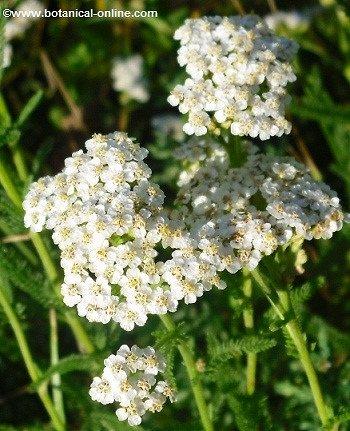
- Skin diseases: The astringent components previously mentioned are very suitable for the external treatment of the skin, such as pimples, eczemas, hematomas and another skin disorders (Decoction of a handful of summit flowers in a litre of water. Soak a piece of cloth in it and apply on the affected part)
This preparation can be also used to disinfect animal wounds or wounds done to people by animal bites. It has been traditionally used in some places to treat snake bites. - Nail ridges: Take a nail bath with the infusion of a couple of tablespoonfuls per cup of water.
- Black or purple nails: To reduce inflammation and prevent your nail to become black or purple. (Decoction of a handful of flower tops per liter of water. Apply with cloth on the affected nail)
- Black eyes: (Decoction of a handful of flower tops per liter of water. Apply with a cloth on the affected eye)
- Emmenagogue: Decoctions of flower summits are appropriate to ease menstruation, in case of painful periods (dysmenorrhea) or when too much mucous is present (blennorrhoea) (Boil a handful of flower summits in a liter of water during 15 minutes. Pour it in the bath or in a basin and make hip baths with this preparation) For inflammation of the uterus or metritis take sitz baths with the infusion of its flowering tops.
- Ovarities: For inflammation of the ovaries or ovaritis take sitz baths with the infusion of flowering tops.
- Varicose veins and haemorrhoids: The above decoctions can be used to treat varicose veins externally. Make leg baths to treat the first ones or drink an infusion of dried flowers. Two cups a day. Hip baths can be used in case of hemorrhoids.
Toxicity of yarrow herb
The contact with the fresh plant, because of the presence of coumarins, can produce allergic reactions on the skin.
The fresh juice can also be photo- toxic, producing eczemas in the skin of people who are exposed to sun rays, specially in high places, where solar radiation is higher.
Do not take in cases of pollen allergy. Sometimes it can produce gastric hypersensitivity.
Picking-up and storing: Flower summits should be collected in spring and autumn. They should be dried in the shade and be stored in a sealed container, once cleaned and dried.
![]() More information about medicinal plants.
More information about medicinal plants.

